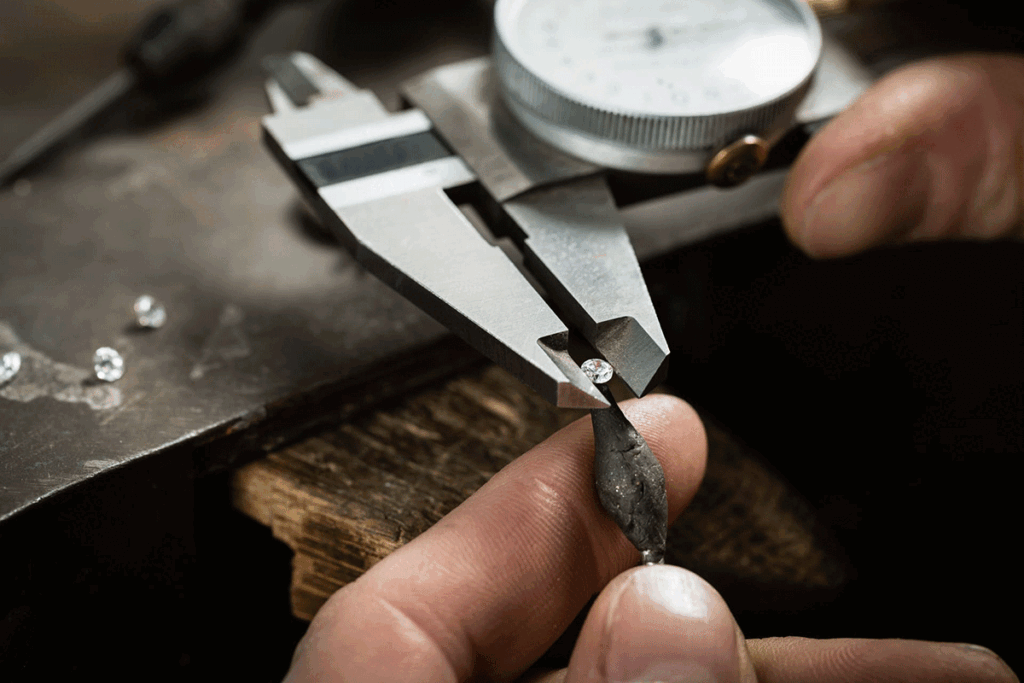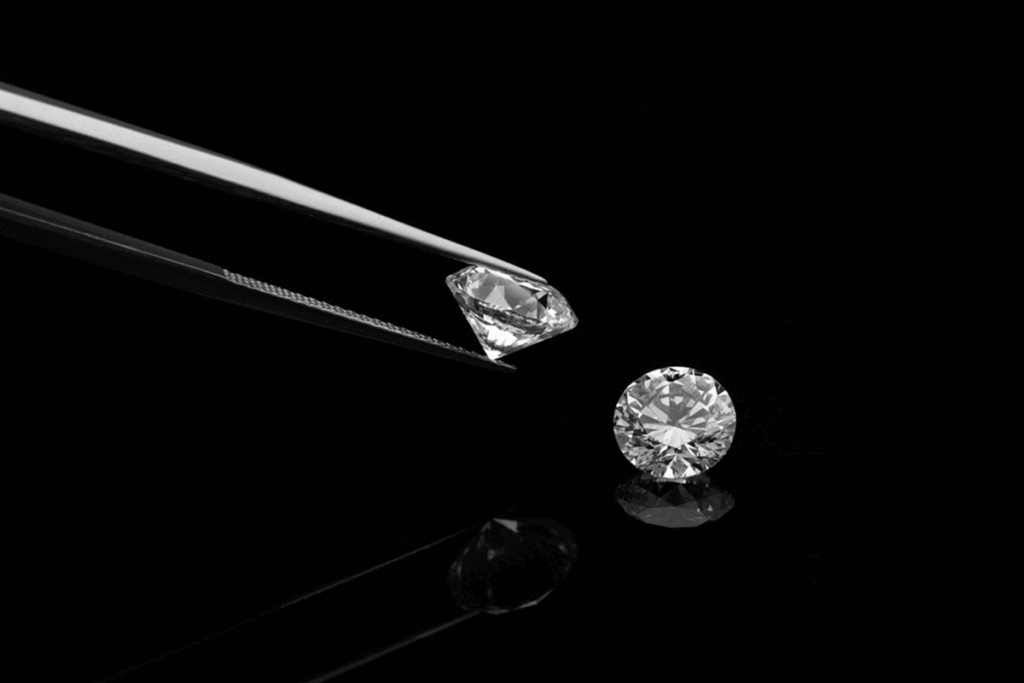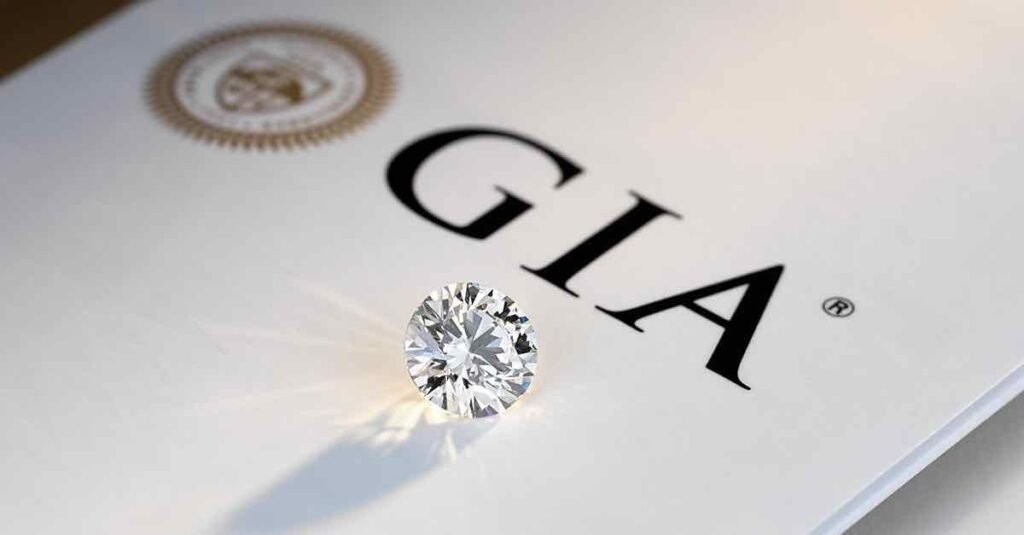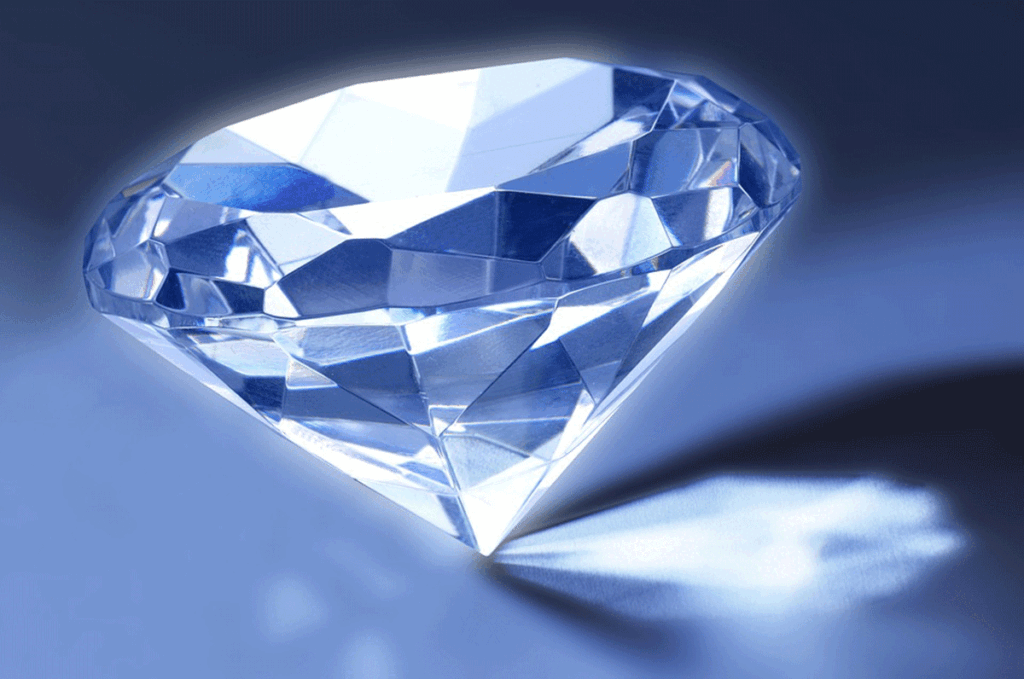Diamonds are graded according to GIA’s 4Cs—clarity, color, carat, and cut. Clarity and color are inherent properties of a stone. Carat is the weight of a diamond. To a large extent, it is a function of the original size of the rough diamond. The diamond cut is the manner by which a rough stone is turned into a sparkling gem. Of the 4Cs, it is considered one of the most important, if not the most important because among other things, the diamond depth hand table resulting from it are responsible for giving a gem that irresistible charm and beauty. But there are other parts of a diamond that deserve your attention—diamond depth and table.
Why are Diamond Depth and Table Important?
Diamond depth and table go hand in hand—proportionally. If the depth is too shallow, the table would be proportionally bigger. Conversely, if the diamond is cut too deep, the table would be proportionally small. In both cases, a gem’s sparkle, brilliance, and fire suffer.
But what are they?
Diamond Depth And Table Relationship
To know what they are and how they are related requires a basic knowledge of a diamond’s anatomy (shown below).

What is a diamond table
The diamond table is that flat surface you see when viewing the diamond face-up. Well, it resembles a table. It is the largest facet of a diamond and its main purpose is to refract the light that enters through it, and reflect it to the pavilion facets and back to the observer’s eyes.
A larger table, however, does not always mean a more brilliant stone. It must be exactly proportional to its depth.
So how big should the table be on a diamond?
It depends on the overall size of the stone. Its size has to be in the right proportion to the other parts of the gem. When jewelers grade a particular stone, they express table size as a percentage of the overall width of the stone. And to get this is to divide the table width by the girdle diameter.
Of course, this percentage varies according to the shape of the stone. For example, for round-cut diamonds, this is 54%-60%. For emerald-cut diamonds like the one in this Natalie Diamonds review, this is between 66%-72%.
The differences in these numbers may seem insignificant but they have a great impact on the diamond’s overall appearance and brightness.
What is diamond depth
Diamond depth (also called height), is the height (in millimeters) measured from the culet (bottom tip) to the table.
Like the table, jewelers also express this in terms of percentage, and the diamond depth calculator is pretty simple and straightforward—divide the total depth by the diamond’s girdle. This depth percentage directly impacts how light is reflected off the facets of the stone.
A diamond’s depth contributes to the gem’s sparkle in a big way. If it is too shallow light will just pass through the pavilion. If it is too deep, the diamond will have a poor sparkle. It makes the stone look smaller than its actual carat weight
Like the table, there is no ideal diamond depth. It is dependent on the shape. So when you go out to buy a diamond, look for a stone that allows light to bounce around the facets, creating that gorgeous brilliance, sparkle, and scintillation.
What Should the Depth and Table be on a Diamond?
Table and depth vary according to the shape of the diamond. For example, below is the best table and depth for round diamond:

- Diamond depth percentage – 59% to 62. 6%
- Table size percentage – 54% to 57%
- Pavilion angle – 40.6% to 41%
- Crown angle – 34% to 35%
- Girdle thickness – Thin to slightly thick
- Culet – none to pointed
As mentioned earlier, other diamond shapes have their respective depth and table ratios. Several sites, particularly Jewelry Shopping Guide, provide comprehensive information about these crucial cut attributes.
Effect of diamond depth and table on quality
The Gemological Institute of America’s (GIA) cut quality grades are Excellent, Very Good, Good, Fair, and Poor. When a stone is cut according to the right proportions and symmetry, naturally it would look more stunning and will be valued higher. On the other side of the scale, if a stone is not properly cut, its value is diminished and graded accordingly.
When shopping for diamonds, assuming everything is equal, the one that has good depth and table always makes a difference.
Effect of diamond depth and table on sparkle
A diamond’s sparkle and dispersion are affected by its cut. But what is the role of depth and table in creating these lovely properties of a gem? Here’s how.
Table
The table governs the amount of light that goes into the stone and is refracted. Hence, its size affects the overall sparkle of the stone.
However, it’s not just about size. It’s its proportion with respect to the diamond’s depth. An extra-wide table will make the diamond look flat and lifeless.
Depth
Depth goes hand in hand with table size in how well a diamond will refract incoming light. If the cut is too deep, the diamond will look dull and lacking in brightness. This is because much of the light that enters the stone travels through it. It is not reflected back to the table.

Likewise, if the cut is too shallow, that light that goes into a diamond will just pass through without creating any sparkle and brilliance. This is what happens with spread diamonds.
Sparkle and brilliance are created when light going into the stone hits a pavilion at the right angle, then reflects it to the opposite pavilion which, in turn, reflects it back to the table.
The simplest comparison is to think of a set of mirrors perfectly arranged to reflect light at 90 degrees.
Choosing the Perfect Diamond
At the outset, the perfect diamond is that which fits your personal preference and taste. If a stone appeals to your innermost instincts, then nothing else matters.

But on the premise that you are still up there, lost and confused in this complex world of diamonds, then this article could help you a lot in making the right decision.
Buying a diamond is a difficult, and often, expensive decision. There are a plethora of factors to consider before whipping out your credit card.
For starters, there are the 4Cs you should get familiar with. On the surface, they are pretty straightforward—carat, color, clarity, and cut. Of the four, Cut is considered the most important,
What makes the diamond cut important
The diamond cut is important because it determines how much light is reflected off a particular stone. A gem may have great color, clarity, and affordable carat weight, but if the cut is bad, it will just be nothing but a lump of shaped glass. It will look dull and lifeless.
The cut is responsible for giving a diamond three desirable properties:
- Brilliance – a measure of the brightness of the reflected and refracted light from a stone.
- Fire – the way a diamond disperses light into visible flashes of color.
- Scintillation – the way a diamond sparkles when moved.
GIA grades diamond cut from Excellent diamonds to Poor, Hence, assuming that the 3Cs are equal, the perfect diamond is one with an excellent cut, or close to it. Excellent-cut diamonds give off an even and clear pattern of brightness with uniform dark areas. They provide the highest level of fire and brilliance.
What makes them exhibit this unmatched beauty is because of their near-perfect proportions and symmetry. All the incoming light is reflected efficiently through the table, facets, and pavilion. Their depth and table are of the right percentages with respect to the other parts of the diamond.
Ideal Depth and Table percentages
Ideal depth (in % of height/average diameter)
- Round brilliant-cut diamonds – 59 to 62.6
- Radiant-cut diamonds – less than 67
- Princess-cut diamonds – 68 to 75
- Pear-shaped diamonds – less than 68
- Oval-cut diamonds – less than 68
- Marquise-cut diamonds – 58 to 62
- Heart-shaped diamonds – 56 to 62
- Cushion-cut diamonds – 61 to 68
- Emerald-cut diamonds – 61 to 68
Ideal table (in % of table width/total diamond diameter)
- Round brilliant-cut diamonds – 53 to 58
- Radiant-cut diamonds – 61 to 69
- Princess-cut diamonds – 67 to 72
- Pear-shaped diamonds – 53 to 63
- Oval-cut diamonds – 53 to 63
- Marquise-cut diamonds – 53 to 63
- Heart-shaped diamonds – 53 to 63
- Cushion-cut diamonds – 61 to 67
- Emerald-cut diamonds – 61 to 69
Where to find perfect diamonds
Now that the air is clear regarding the importance of diamond depth and table, it’s time to search for your perfect diamond. There are two ways to do that…
Buy Online
The pandemic ushered in a new mode of shopping—online. These days, you can buy anything online—even diamonds. In fact, online diamond shopping is estimated to be around 5% to 10% of the total polished diamond business in the US. Its dismal performance has a reason—diamond experts believe shopping online is not the best way to buy these precious gems.
But it’s not all that gloomy. Leading diamond dealers have websites for people to shop from the comforts of their homes, Should you be one of them, there are some things to keep in mind so that you will get the value promised in the product description and accompanying photos. A lot of unethical vendors “tweak” their photos to make their diamonds look more impressive than they actually are.
Yes, your choices will be based on photographs of diamonds in a dealer’s inventory, thousands of them. To narrow down your choices, search based on categories. And be sure the photos can be rotated so they can be viewed all around, either close up or enlarged.
Don’t forget to check the detailed description of the stone of your choice, as well as the grading report together with the grading institution that wrote it. There are several diamond grading institutions but the most trusted are the GIA and the AGS (American Gem Society).
Buy Offline
Some people might call you old-fashioned if you buy offline. But this is still the best way to shop—especially for diamonds.

Offline shopping allows you to see, first hand, feel, and make instant buying decisions. And you can take home your purchase immediately.
Sadly, buying diamonds of the right depth and table is not as easy as buying a pair of shoes.
In buying a diamond, first and foremost, keep in mind the 4Cs. While color, carat weight, and clarity can easily be determined, the cut is more complex to analyze. And unless you shop carrying with you an accurate measuring tool, there is no way for you to determine the depth and table measurements, much more their percentages. Except for the grading report, you have no way to make the right decision.
Hence, the grading report is very crucial. Ask for it and read it through thoroughly. Be sure it was issued either by the GIA or the AGS. Even if you can distinguish diamond shapes, you may not understand its technical details.
From the grading report, check a stone’s depth and table measurements. Try to make sense of the cut grade because the depth and table percentages are the finer elements of a diamond’s cut. Make sure that the diamond of your choice is your preferred grade.
At this point, you must know that the ideal diamond depth and percentages don’t impact your budget much. Since they are expressed in percentages, they remain constant no matter the diamond’s weight, clarity, and color.
Bottom Line
There are a lot of factors to be considered in deciding on the ideal diamond. The starting point is the 4Cs, they being the most well-known, and often-used standard in determining diamond quality. And among the salient items in such a standard are diamond depth and table. They are crucial diamond components that play a huge role in their sparkle, light dispersal, and brilliance.
Knowing a diamond’s depth and rating can help you select the ideal diamond of your choice. However, don’t be so focused on these two parameters. There are many factors that will ultimately affect the overall quality of a stone.
But after all is said and done, after weighing all the attributes that appeal to your senses and budget, what matters most is how a particular stone resonates with your personal characteristics and lifestyle. After all, there is no size that fits all.
Now that you know more about diamond depth and table, you might be interested in other diamond parts. Check out our article, “What’s the Point? What Your Diamond Culet Means To Your Jewelry.”

